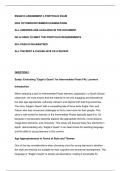ENG2613 ASSIGNMENT 4 PORTFOLIO EXAM
2024 OCTOBER/NOVEMBER EXAMINATIONS
ALL ANSWERS ARE AVAILABLE IN THE DOCUMENT
NO AI USED TO MEET THE PORTFOLIO REQUIREMENTS
90% PASS IS GUARANTEED
ALL THE BEST & PLEASE GIVE US A REVIEW
QUESTION 1
Essay: Evaluating "Eagle’s Quest" for Intermediate Phase FAL Learners
Introduction
When selecting a text for Intermediate Phase learners, especially in a South African
classroom, we must ensure that the material is not only engaging and educational
but also age-appropriate, culturally relevant, and aligned with learning outcomes.
The story “Eagle’s Quest” tells a compelling tale of three birds Eagle, Owl, and
Falcon who face numerous challenges to find a new home for their people. This
story is well-suited for learners in the Intermediate Phase (typically aged 9 to 12)
because it incorporates essential aspects like appropriate themes, moral lessons,
imaginative elements, and inclusivity. This essay will discuss these four elements in
depth, demonstrating why “Eagle’s Quest” is an ideal choice for teaching language
and life skills to young learners in this context.
Age Appropriateness in Terms of Style and Themes
One of the key considerations when choosing a text for young learners is whether
the style and themes are suitable for their cognitive and emotional development. The
language in “Eagle’s Quest” is simple yet descriptive, making it accessible for
, learners who are still building their language proficiency. This is particularly important
for FAL (First Additional Language) learners who might find complex vocabulary and
sentence structures overwhelming. The story uses clear and straightforward
language, ensuring that learners can follow the narrative without getting lost or
frustrated.
Moreover, the themes of leadership, perseverance, teamwork, and overcoming
adversity are highly relevant to this age group. Children in the Intermediate Phase
are beginning to understand abstract concepts like responsibility and resilience,
making it the perfect time to introduce stories that reflect these values. The
characters in the characters on the strong leadership, Owl’s wisdom, and Falcon’s
courage—that learners can aspire to. The challenges they face, such as crossing
dangerous terrain and enduring harsh conditions, mirror real-life difficulties, albeit in
a simplified manner. This helps learners relate to the characters’ experiences and
apply the lessons to their own lives.
The adventurous nature of the story is also appealing to young readers. The idea of
embarking on a journey through different landscapes and encountering various
obstacles captures their imagination and keeps them engaged. By combining familiar
narrative elements like quests and brave heroes—with a context that feels fresh and
exciting, “Eagle’s Quest” strikes a balance that is both age-appropriate and highly
engaging.
Moral and Ethical Learning
Stories are powerful tools for teaching values and ethics, and “Eagle’s Quest” is no
exception. One of the central themes of the story is leadership. Eagle, as the leader
of her people, demonstrates qualities like selflessness, courage, and determination.
When faced with a crisis, she does not think of herself but of her people, deciding to
risk her safety to find a new home for them. This is an excellent example for young
learners, who are at an age where they are starting to develop their own sense of
right and wrong. Eagle’s actions teach them the importance of thinking beyond one’s
own needs and making decisions that benefit others.




